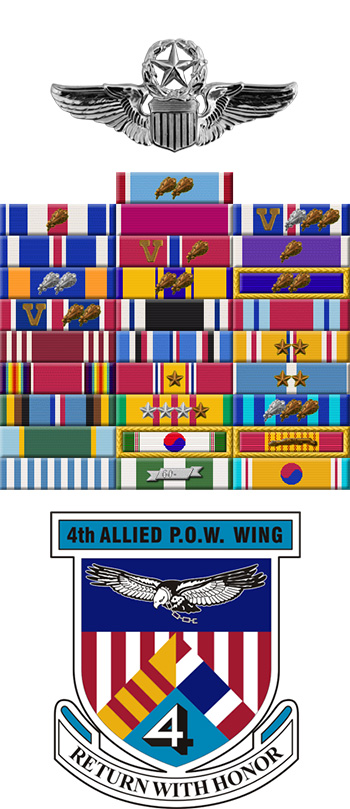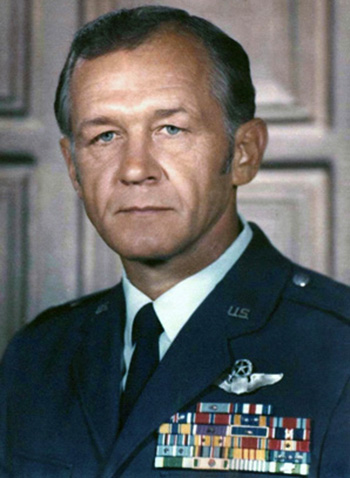
|
James H. "Jim" Kasler |
 |
|||
| Rank, Service | ||||
Colonel O-6, U.S. Air Force |
||||
| Veteran of: | ||||
|
||||
| Tribute: | ||||
Jim Kasler was born on May 2, 1926, in South Bend, Indiana. He enlisted in the U.S. Army Reserve on November 24, 1943, and went on active duty with the U.S. Army Air Forces on May 16, 1944. After completing basic training and aerial gunnery training, Sgt Kasler deployed to the Pacific as a B-29 Superfortress tail gunner with the 5th Bomb Squadron of the 9th Bomb Group on Tinian from June 1945 to May 1946, during which time he flew 6 combat missions during the closing months of World War II. He returned to the U.S. in early May 1946, and left active duty and joined the Air Force Reserve on May 21, 1946. Kasler enlisted in the Aviation Cadet Program of the U.S. Air Force on February 28, 1950, and was commissioned a 2d Lt and awarded his pilot wings on March 24, 1951. Lt Kasler next completed F-84 Thunderjet Combat Crew Training before serving as an F-86 Sabre pilot with the 74th Fighter Interceptor Squadron (FIS) at Presque Isle AFB, Maine, from July to November 1951. He then deployed to Korea where he served as an F-86 pilot with the 335th FIS at Kimpo AB, South Korea, from November 1951 to June 1952. During this time he was credited with the destruction of 6 MIG-15 fighters destroyed in aerial combat, and 2 more damaged, while flying 101 combat missions during the Korean War. His next assignment was as a fighter gunnery instructor with the 3594th Fighter Training Squadron at Nellis AFB, Nevada, from August 1952 to July 1954, followed by service as a Research and Development pilot with the 3525th Aircraft Gunnery Squadron at Nellis from July 1954 to July 1955. Capt Kasler served as an instructor pilot with the Royal Canadian Air Force on the Central Coordinating Staff in Ottawa, Canada, from July 1955 to July 1957, and then as an F-100 Super Sabre pilot with the 308th Fighter Bomber Squadron at Turner AFB, Georgia, from September 1957 to February 1959. His next assignment was as an F-105 Thunderchief pilot with the 334th Tactical Fighter Squadron (TFS) at Seymour Johnson AFB, North Carolina, from February 1959 to November 1962, when he received an assignment to the University of Omaha in Omaha, Nebraska, where he earned his bachelor's degree in June 1963. He next served as an F-105 pilot with the 53rd TFS and on the staff of the 36th Tactical Fighter Wing (TFW) at Bitburg AB, West Germany, from July 1963 to February 1966, when he deployed directly to Southeast Asia. Maj Kasler served as an F-105 pilot with the 354th TFS at Takhli Royal Thai AFB, Thailand, from February 1966 until he was forced to eject over North Vietnam and was taken as a Prisoner of War while flying his 91st combat mission on August 8, 1966. After spending 2,401 days in captivity, Col Kasler was released during Operation Homecoming on March 4, 1973. He was briefly hospitalized to recover from his injuries at Wright Patterson AFB, Ohio, and then attended Air War College at Maxwell AFB, Alabama, from August 1973 to July 1974. Col Kasler's final assignment was as an F-111 Aardvark pilot and Vice Commander of the 366th TFW at Mountain Home AFB, Idaho, from August 1974 until his retirement from the Air Force on May 1, 1975. Col Kasler is the only person ever to be awarded the Air Force Cross three times. Jim Kasler Flew West on April 24, 2014, and was buried at the Crown Hill Cemetery in Indianapolis, Indiana. His 2nd (of 3) Air Force Cross Citation reads: Major James H. Kasler distinguished himself by extraordinary heroism in connection with military operations against an opposing armed force as an F-105 Thunderchief pilot near Yen Bay, North Vietnam, on 6 August 1966. On that date, Major Kasler led a flight of fighter-bombers against a heavily defended target in evaluating a low level ordnance delivery tactic. While carrying out this hazardous mission, a wingman was forced to eject over unfriendly territory. Major Kasler located the downed airman and flew cover until perilously low fuel compelled him to leave. Refueling aerially, Major Kasler returned to relocate the downed pilot so he could direct rescue operations. At great risk to his own life, he explored the gun infested countryside at tree-top level, valiantly searching, but was unable to locate his fellow American. Major Kasler's Thunderchief was hit by destructive ground fire during this valorous search, and he too ejected into unfriendly hands. Through his extraordinary heroism, superb airmanship, and aggressiveness in the face of hostile forces, Major Kasler reflected the highest credit upon himself and the United States Air Force. |
||||
|
||||

